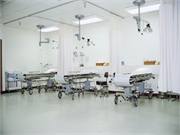Leading up to COVID-19 outbreak, 2.2 hospital beds available per 1,000 persons, but most occupied
WEDNESDAY, March 25, 2020 (HealthDay News) — Leading up to the coronavirus disease 2019 (COVID-19) outbreak, about 2.2 beds were available per 1,000 people in U.S. hospitals; however, only 36 percent were unoccupied on a typical day, according to a report from the Robert Wood Johnson Foundation.
Fredric Blavin, Ph.D., and Diane Arnos, from the Urban Institute Health Policy Center, used data from the 2018 American Hospital Association Annual Survey for 6,500 U.S. hospitals to examine the current capacity independent of the spread of COVID-19.
The researchers estimated that there were approximately 728,000 hospital beds in the United States, or 2.2 beds per 1,000 people, in 2018, excluding children’s hospitals, bassinets for infants, and specialty hospitals to focus on the capacity relevant for COVID-19 treatment. On an average day in 2018, 36 percent of these beds were unoccupied. There was considerable variation in occupancy rates by hospital size; the highest rates of unoccupied beds were seen at the smallest hospitals: About 71 percent of beds were unoccupied among hospitals with six to 24 beds compared with about 26 percent in hospitals with 500 or more beds. The technology and services provided in smaller hospitals with higher percentages of unoccupied beds generally lag behind larger hospitals.
“Understanding aggregate hospital bed capacity and how it varies across the country is essential for effectively responding to the pandemic and assuring that as many patients as possible get the care they may urgently need,” the authors write.
Copyright © 2020 HealthDay. All rights reserved.








